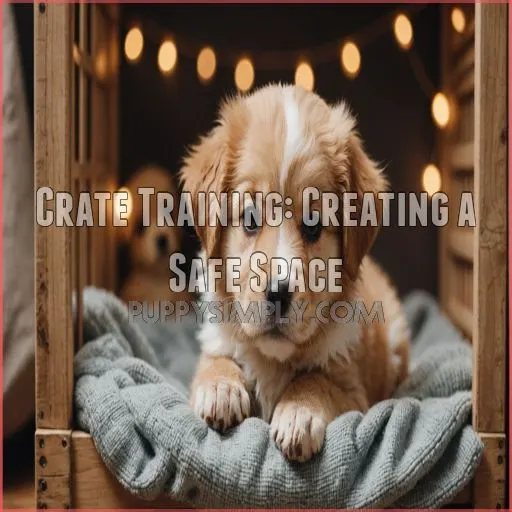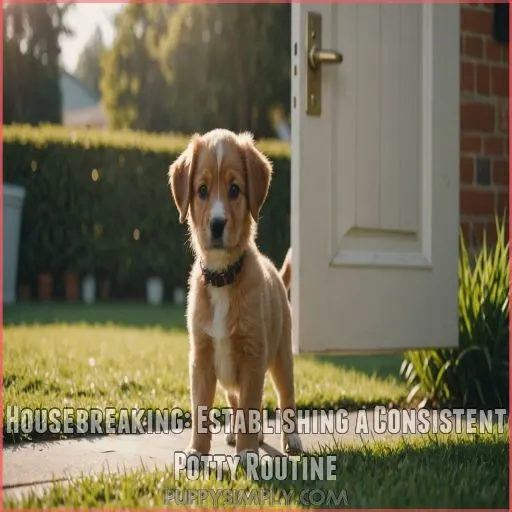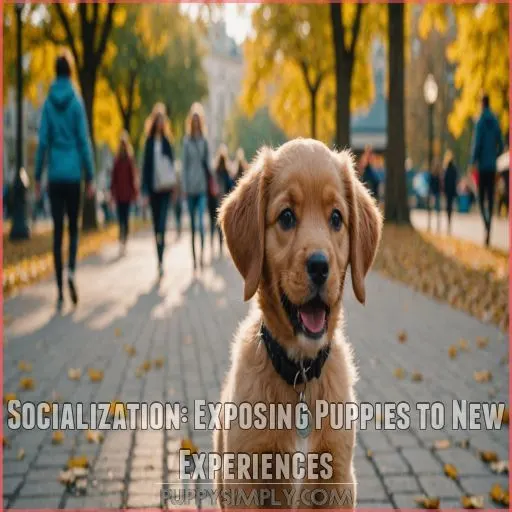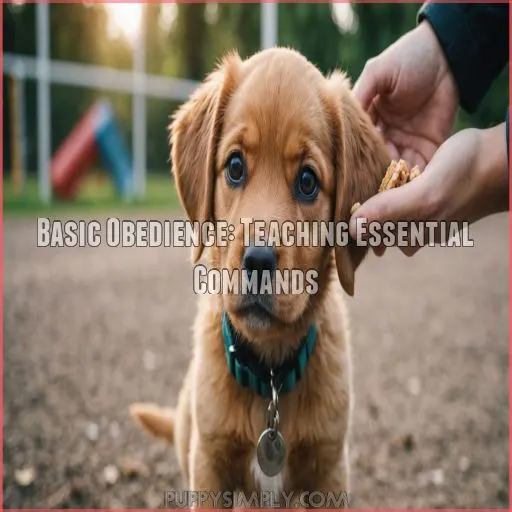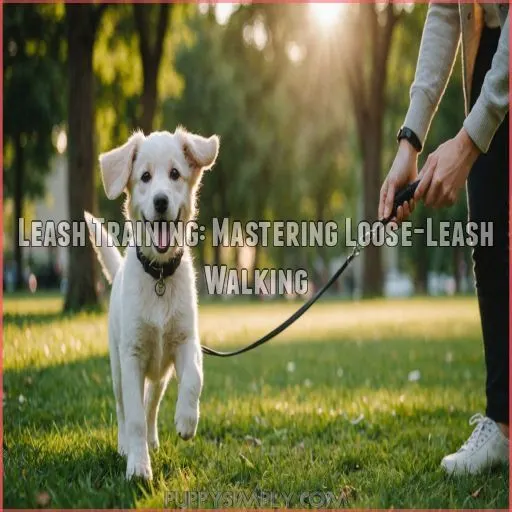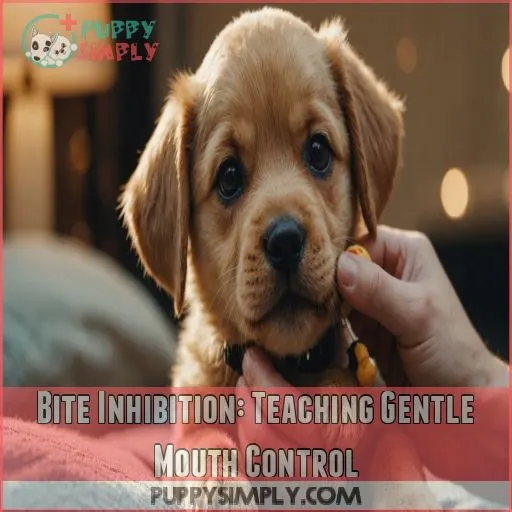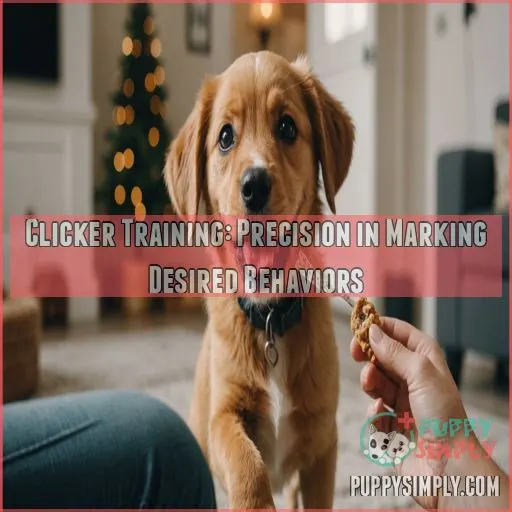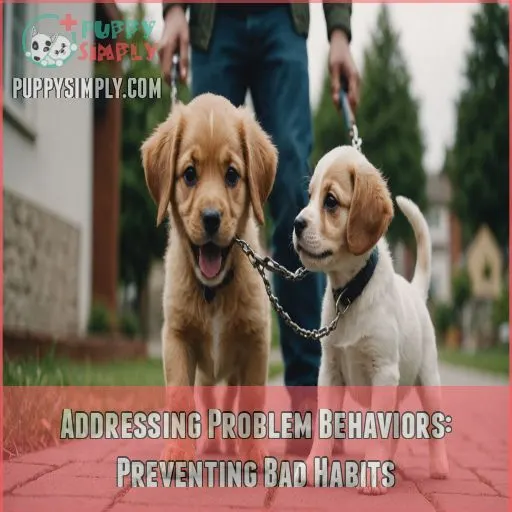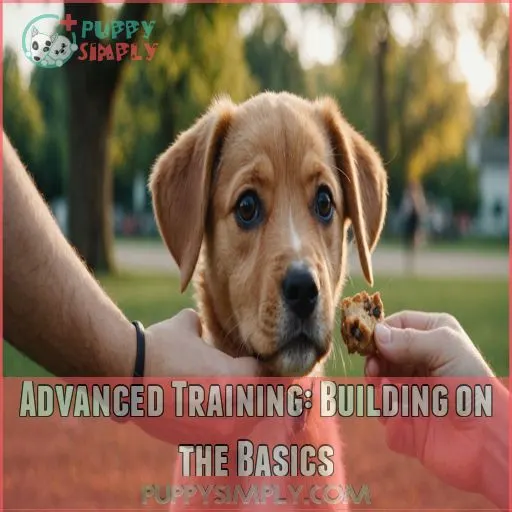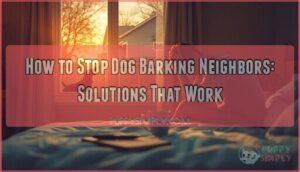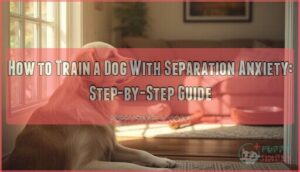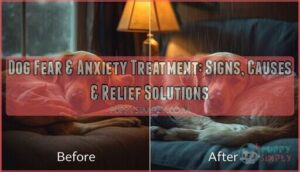This site is supported by our readers. We may earn a commission, at no cost to you, if you purchase through links.

Imagine crate training as crafting a cozy den—you’re creating a pup-sized haven.
And remember, housebreaking‘s about building routines, not a mess management mission.
Socialization’s your secret weapon against puppy awkwardness; just like introducing a shy kid to the playground! Curious about these methods in action? We’ve got more puppy-tailored wisdom just ahead!
Table Of Contents
- Key Takeaways
- Positive Reinforcement: the Foundation of Puppy Training
- Crate Training: Creating a Safe Space
- Housebreaking: Establishing a Consistent Potty Routine
- Socialization: Exposing Puppies to New Experiences
- Basic Obedience: Teaching Essential Commands
- Leash Training: Mastering Loose-Leash Walking
- Bite Inhibition: Teaching Gentle Mouth Control
- Clicker Training: Precision in Marking Desired Behaviors
- Addressing Problem Behaviors: Preventing Bad Habits
- Advanced Training: Building on the Basics
- Frequently Asked Questions (FAQs)
- How do I choose the right training treats for my puppy?
- What is the best way to train a puppy with a short attention span?
- How can I ensure consistency in training across multiple family members?
- When should I start incorporating advanced training techniques?
- How do I address puppy behaviors like jumping and nipping during training?
- Conclusion
Key Takeaways
- Positive reinforcement is your best friend when training your pup. Instead of the guilt trip, reward good behavior with treats, praise, and play. Remember, catching them being good is half the battle won!
- crate training isn’t just a timeout spot—it’s your puppy’s personal retreat. Think of it as creating a safe space where they can dream of chew toys and belly rubs, just like with stress relief. Plus, it’s a lifesaver for potty training and teaching independence for stubborn bichons.
- Consistency in training is your secret weapon. Just like sticking to a knock-knock joke routine with family, everyone should use the same cues and rewards. Teamwork makes sure you’re all on the same training page.
- Socialization is like introducing a shy kid to the playground. Expose your pup to different people, dogs, and environments. You’re building a confident, well-adjusted dog ready for any adventure—like a canine superhero in training!
Positive Reinforcement: the Foundation of Puppy Training
You’re about to start an exciting journey with your new furry friend, and positive reinforcement is your secret weapon for success.
By focusing on rewarding good behavior rather than punishing mistakes, you’ll build a strong bond with your puppy and create a foundation for a lifetime of happy training experiences.
Reward-based Training Techniques for Puppies
Helping your puppy reach their full potential starts with reward-based training.
You’ll build a strong bond and shape good behavior by focusing on what your pup does right.
It’s all about catching them being good!
Using Treats, Praise, and Play as Motivators
You’ve got a secret weapon in puppy training: treats, praise, and play and a consistent potty schedule!
These powerful motivators make learning fun for your furry friend.
Mix it up with different rewards to keep your pup engaged and excited to please.
Timing and Consistency in Positive Reinforcement
Timing is everything in puppy training, especially when it comes to potty training a Shih Tzu like this guide explains.
To boost your pup’s learning, reward them immediately after good behavior.
Stay consistent with your praise and treats, even when life gets hectic.
Your furry friend will thank you!
Avoiding Punishment and Negative Reinforcement
Now, let’s focus on why punishment isn’t the way to go.
Instead of scolding your pup, try redirecting their attention.
It’s like teaching a toddler – positive guidance works wonders!
Your furry friend will thank you.
Building Trust and Confidence Through Positive Experiences
Positive experiences lay the foundation for a well-adjusted pup.
By creating a safe, fun environment filled with rewards and praise, you’ll build an unshakable bond.
It’s like being your puppy’s personal cheerleader – woof woof, go team!
Crate Training: Creating a Safe Space
Creating a cozy den for your pup isn’t just about giving them a comfy spot to snooze—it’s a game-changer for potty training and teaching independence.
With the right approach, you’ll turn that crate into your furry friend’s favorite hangout spot faster than you can say "Who’s a good boy?
Choosing the Right Crate Size and Type
Picking the right crate is really important for your pup’s comfort and safety.
You’ll want to think about size, material, and style.
A wire crate that’s just big enough for standing and turning is ideal.
Introducing the Puppy to Their Crate
Start by placing the crate in a cozy spot where your pup can see you.
Leave the door open and let your furry friend explore at their own pace.
Remember, patience is key!
Establishing a Positive Association With the Crate
To make your puppy’s crate a happy place, sprinkle it with treats and cozy bedding.
Play fun games nearby, and offer special chews inside.
Soon, they’ll see their crate as a personal retreat!
Using the Crate for Housebreaking and Quiet Time
During the puppy blues, your crate becomes a lifesaver.
You’ll both appreciate the structure!
Use it for housebreaking by taking your pup out after naps, and create a peaceful den for quiet time.
Gradually Increasing Crate Time and Independence
Patience is key when increasing your puppy’s crate time. Gradually extend their stays to build independence and confidence.
Here’s how:
- Start with short sessions
- Use engaging toys
- Practice during daytime activities
- Slowly work up to overnight stays
Housebreaking: Establishing a Consistent Potty Routine
You’re about to get started on one of the most important (and sometimes messy) parts of puppy training: housebreaking.
By establishing a consistent potty routine, you’ll teach your furry friend where and when to do their business, saving your floors and your sanity in the process.
Setting Up a Designated Potty Area
You’ve got your pup’s cozy crate set up, now let’s tackle the potty zone!
Choose a spot that’s easy to clean and always accessible.
Grass patches or puppy pads work wonders for indoor training.
Creating a Regular Feeding and Potty Schedule
Now that you’ve set up your puppy’s potty area, let’s tackle the feeding and potty schedule.
Creating a routine is key to successful housebreaking.
Here’s what you need to know:
- Feed at consistent times daily
- Take potty breaks after meals, naps, and play
- Adjust frequency based on your pup’s age
- Stick to the schedule, even on weekends
Recognizing Signs That Your Puppy Needs to Go
Let’s talk about your pup’s potty signs.
Watch for the telltale clues: whining, sniffing, circling, or sudden squatting.
These are your pup’s way of saying, "Hey, I gotta go!"
Stay alert!
Positive Reinforcement for Successful Outdoor Elimination
Once your pup shows signs of needing to go, it’s showtime! Celebrate their outdoor success with a potty party. Here’s how to make it rain rewards:
- Throw a treat fiesta the moment they finish
- Shower them with enthusiastic praise
- Offer a quick play session with their favorite toy
- Give them a gentle pat or scratch in their favorite spot
Handling Accidents Calmly and Effectively
How should you react when your puppy has an accident? Stay calm and avoid scolding.
Clean thoroughly with enzymatic cleaner to eliminate odors.
You’ve got this!
Socialization: Exposing Puppies to New Experiences
You’re about to enter a key phase of puppy training: socialization.
Exposing your furry friend to a variety of people, animals, and environments during their early weeks will help shape them into a confident, well-adjusted adult dog.
Introducing Puppies to Various People, Animals, and Environments
Introducing your puppy to a world of new experiences is like opening a treasure chest of possibilities. Your furry friend’s socialization journey should include:
- Meeting friendly, diverse people
- Encountering well-behaved dogs
- Exploring various indoor spaces
Socialization journey is crucial to help your puppy grow into a well-adjusted adult dog.
- Discovering outdoor environments
- Interacting with different animals
Positive Exposure to Different Sounds, Textures, and Situations
After meeting new friends, it’s time to broaden your pup’s horizons! Expose them to various sounds, textures, and situations to build confidence.
Here’s a handy guide to get you started:
| Sounds | Textures | Situations | Reactions |
|---|---|---|---|
| Vacuum | Grass | Car rides | Tail wagging |
| Thunder | Tile | Elevator | Curiosity |
| Doorbells | Carpet | Stairs | Caution |
| Traffic | Wood | Crowds | Excitement |
Expose your puppy to various sounds like a vacuum, thunder, doorbells, and traffic.
Introduce them to different textures such as grass, tile, carpet, and wood.
You can also expose them to situations such as car rides, elevators, stairs, and crowds.
Puppy Classes and Supervised Playdates
Puppy classes and playdates are two fantastic ways to socialize your furry friend. They offer a safe environment for your pup to:
- Make new doggy pals
- Learn proper play etiquette
- Practice obedience skills
- Build confidence around other dogs
Building Confidence Through Controlled Exposure
Your pup’s confidence blossoms through controlled exposure.
Start small, introducing new sights, sounds, and textures in bite-sized chunks.
Gradually increase intensity and duration, always keeping experiences positive.
You’re building a brave, well-adjusted canine companion!
Addressing Fear and Anxiety During Socialization
Fear can cast a shadow over socialization efforts.
Don’t fret! When your pup shows signs of anxiety, take a step back.
Gradually expose them to new experiences, pairing each with treats and praise.
You’ve got this!
Basic Obedience: Teaching Essential Commands
Teaching your puppy basic obedience commands is like giving them the keys to successful communication with humans.
By mastering essential cues like "sit," "stay," "come," and "leave it," you’ll set the foundation for a well-behaved and happy pup that’s a joy to be around.
Teaching Sit, Stay, Come, and Leave It
Master the art of teaching your furry friend essential commands like sit, stay, come, and leave it.
These foundational skills form the building blocks of a well-behaved pup,
paving the way for a harmonious human-canine relationship.
Using Hand Signals Alongside Verbal Cues
Hand signals are like secret codes for your pup!
Pairing them with verbal cues creates a powerful communication duo.
Watch your furry friend’s eyes light up as they decode your gestures and words together.
Practicing Commands in Different Environments
Now that your pup’s got the hang of hand signals, it’s time to take their training on the road! Practicing commands in different environments helps your furry friend become a well-behaved pooch anywhere you go.
Try commands at the dog park with playful distractions
- Try commands at the dog park with playful distractions
- Practice on various surfaces like grass, concrete, and sand
- Test their skills in new locations with different noise levels
Gradually Increasing Duration and Distance of Commands
Once your pup’s got the basics down, it’s time to level up!
Start stretching out those "stays" and calling your furry friend from further away.
Incorporating Obedience Into Daily Routines
You’ve mastered basic commands, but the real magic happens when you weave them into your pup’s daily life. It’s like turning your regular routines into a fun training playground!
Leash Training: Mastering Loose-Leash Walking
You’re about to start one of the most rewarding (and sometimes challenging) aspects of puppy training: leash walking.
Mastering loose-leash walking will make your daily strolls more enjoyable but will also strengthen the bond between you and your furry friend.
Introducing the Collar and Leash
Start off on the right paw by introducing your puppy to their collar and leash.
Let them sniff and explore these new accessories before gently placing them on.
Reward their calm acceptance with treats and praise.
Teaching Puppies to Walk Without Pulling
Leash-training your pup can be a walk in the park with the right approach.
Choose a harness or gentle leader to prevent pulling habits.
Keep walks short and fun, rewarding your furry friend for staying close.
Using Positive Reinforcement for Good Leash Behavior
Your pup’s leash manners can be transformed with positive reinforcement. Reward good behavior to create a pawsitive walking experience.
Here are some tips:
- Use high-value treats as you stroll
- Praise enthusiastically for walking nicely
- Stop and wait when pulling occurs
- Practice in low-distraction areas first
- Gradually increase challenge levels
Addressing Common Leash Issues (lunging, Barking)
While you’ve made progress with loose-leash walking, you might encounter some bumps in the road. Let’s tackle common leash issues head-on:
| Issue | Solution |
|---|---|
| Lunging | Use a "Look at Me" cue to redirect focus |
| Barking | Reward quiet behavior and ignore outbursts |
| Pulling | Stop walking when tension occurs |
| Fear freezing | Gradually expose to triggers from afar |
| Zigzagging | Keep treats by your side to guide straight |
Common Leash Issues can be addressed with a few simple solutions.
Redirect Focus when your dog lunges, Reward Quiet Behavior when your dog barks, and Stop Walking when your dog pulls.
Progressing to Off-leash Reliability in Safe Areas
Once your pup’s mastered loose-leash walking, it’s time to spread those wings!
Start in fenced areas, gradually increasing distractions.
Use a long line for safety, rewarding recalls generously.
Trust and patience are your best friends here.
Bite Inhibition: Teaching Gentle Mouth Control
You’ve taught your pup to sit and stay, but those sharp little teeth are still a challenge.
Teaching bite inhibition is important for your puppy’s development, ensuring they learn to control their mouth and play gently with humans and other dogs.
Understanding Puppy Mouthing and Nipping Behavior
Through the lens of puppy development, mouthing and nipping are natural behaviors. Puppies explore their world with their mouths, but it’s important to teach them gentle control. Here’s what you need to know:
- Puppy teeth are razor-sharp for a reason
- Teething stages can intensify mouthing
- Play biting is different from aggressive biting
- Age-appropriate toys can soothe sore gums
- Understanding these behaviors helps you stay patient
Redirecting Biting to Appropriate Chew Toys
When your pup starts nipping, don’t panic!
Grab their favorite chew toy and make it irresistible.
Wave it around, squeak it, or even pretend to chew it yourself.
They’ll soon forget about your fingers!
Teaching Gentle and No Bite Commands
How can you teach your puppy to be gentle?
Start by introducing the "gentle" command during playtime.
When your pup mouths your hand, say "gentle" and immediately praise them for using a softer bite.
Consistency is key!
Addressing Overexcited Play Biting
Teaching bite control is great, but what about those wild play sessions?
Overexcited pups can turn into little sharks!
Let’s tackle those puppy zoomies and set playtime boundaries before someone gets nipped.
Encouraging Appropriate Play With Humans and Other Dogs
After addressing play biting, encourage safe play by establishing playtime boundaries.
Playtime boundaries help ensure safe interactions.
Introduce puppies to puppy play groups, using redirection techniques and socialization games to promote positive interactions with humans and other pups.
Clicker Training: Precision in Marking Desired Behaviors
clicker training might feel like teaching your puppy to use a tiny Polaroid camera, capturing their best moments with a "click."
This method is a fun, precise way to mark desired behaviors, helping your puppy understand exactly what earns them a reward and making training sessions more rewarding for both of you, which is crucial for socialization!
Timing and Coordination of Clicks and Rewards
When it comes to clicker training, timing is everything.
You’ll want to click as soon as your puppy does the desired action—think of it as taking a snapshot!
Deliver the reward quickly too, ensuring your accuracy and frequency match.
Using the Clicker for Shaping New Behaviors
With a clicker, you can shape new behaviors by marking the exact moment your puppy does something right, then rewarding that action. It’s a powerful tool for teaching complex tricks!
Fading Out the Clicker as Behaviors Become Reliable
You’ve shaped new behaviors with the handy clicker, but now it’s time to fade it out.
Gradually reduce its use by following these steps:
- Reward less frequently.
- Use verbal praise instead.
- Give treats intermittently.
- Maintain consistency.
Combining Clicker Training With Other Methods
Think of clicker training as the cherry on top of your training sundae.
Combine it with positive reinforcement and obedience commands to paint a full picture.
Your puppy’s socialization journey will become a delightful dance as they learn gracefully!
Addressing Problem Behaviors: Preventing Bad Habits
Preventing bad habits in puppies is like baby-proofing your house—only with more chewing and barking!
By understanding and managing problem behaviors early on, you’ll save your slippers and your sanity.
Managing Jumping, Barking, and Chewing Behaviors
Curb puppy jumping, barking, and chewing by redirecting their energy to appropriate toys and activities. Reward calm behavior to reinforce the habits you want to see.
Dealing With Separation Anxiety in Puppies
Spot puppy anxiety signs like a hawk.
Use crate comfort and calming routines.
Gradual leaving soothes them, and consistency‘s your best buddy.
It’s like leaving a rock concert—take it slow, no rush.
Preventing Resource Guarding and Food Aggression
Resource guarding isn’t fun—especially when dinner turns into a showdown!
Try food bowl games and safe feeding; socialization aids too.
Watch your pup’s body language for early intervention to maintain harmony.
Addressing Fear and Reactivity Early On
When facing fear-based aggression, use early desensitization, and socialize with care. Address puppy anxiety and triggers by following these steps:
- Use gradual exposure.
- Reward calm behavior.
- Stay patient.
Using Management and Redirection for Unwanted Behaviors
Curb unwanted behaviors by redirecting your pup’s energy.
Provide chew toys for biting, timeouts for jumping, and puzzle feeders for boredom.
Stay one step ahead – prevention is key!
| Behavior | Management Tip | Redirection Tip |
|---|---|---|
| Biting | Offer chew toy | Praise calm behavior |
| Jumping | Ignore, then reward calmness | Teach "sit" or "off" |
| Barking | Avoid rewarding with attention | Teach "quiet" command |
| Chewing | Puppy-proof environment | Provide appropriate chew toys |
Redirect your pup’s energy by providing alternative activities.
For example, if your pup is biting, offer them a chew toy.
If they are jumping, ignore them and then reward calmness.
If they are barking, avoid rewarding them with attention.
Advanced Training: Building on the Basics
Ready to take your puppy’s training to the next level?
Advanced training lets your dog show off new tricks, tackle scent games, and even prepare for therapy work, making every day a chance to impress and have fun together!
Teaching Tricks and Complex Behaviors
Mastering basic commands sets the stage for teaching tricks and shaping behavior.
Imagine this: your dog mastering agility training and advanced obedience, solving problems like a canine detective!
With patience, clear cues, and fun, you’ll both enjoy the learning journey.
Scent Work and Nose Games for Mental Stimulation
Now, let’s sniff out a whole new level of fun with scent work and nose games.
These mental enrichment activities act as boredom busters and puzzle toys for your pup, turning their natural instincts into a thrilling game of hide and seek!
Off-leash Reliability and Recall in Distracting Environments
Mastering off-leash recall in distracting settings takes time and patience. Start in low-distraction areas, gradually increasing difficulty as your pup nails the basics. Reward heavily for prompt responses – a treat jackpot works wonders! Safety first – keep a long line handy.
- Start in low-distraction areas and slowly build up
- Reward heavily for prompt, reliable recall responses
- Use a long line for safety and control in public
- Practice in varied environments to generalize the skill
Preparing for Therapy or Service Dog Work
Thinking about training your puppy for therapy work? Start with temperament assessment and early socialization.
Health screenings are super important, too.
Master basic obedience first, then move into advanced training.
Frequently Asked Questions (FAQs)
How do I choose the right training treats for my puppy?
Choose soft, chewy treats your puppy drools over.
Keep them small for tiny tummies and tantalizing taste buds.
Mix it up with flavors.
Don’t overdo it, or your pup might pack on the pounds!
Happy training!
What is the best way to train a puppy with a short attention span?
Keep your puppy’s training sessions short and sweet, like bite-sized snacks.
Use tasty treats, engaging toys, and lots of praise.
Mix in fun games, stick to a routine, and remember: patience is a virtue!
How can I ensure consistency in training across multiple family members?
Ready for a twist? Create a "Family Puppy Training Pact". Everyone must sing from the same hymn sheet!
Hold family meetings, share cheat sheets with commands, and reward each other’s training efforts.
Teamwork makes the puppy dream work!
When should I start incorporating advanced training techniques?
You can start incorporating advanced training techniques once your puppy has mastered the basics like sit, stay, and come, and you’ve addressed any potential issues with pica.
Gradually introduce more complex commands and tricks as your pup’s skills and confidence grow.
Don’t rush the process – take it one step at a time.
How do I address puppy behaviors like jumping and nipping during training?
Did you know over 80% of puppies nip and jump?
Redirect nipping with chew toys and use consistent cues for jumping.
A little patience goes a long way—persistence and a sense of humor are your best allies!
Conclusion
Raising a puppy can feel like herding cats, but when you embrace the best dog training methods for puppies, success is within reach!
You’re shaping well-behaved companions using positive reinforcement, crate training, housebreaking, and socialization.
Mix in some clicker magic and leash wisdom, and watch your puppy flourish.
So, roll up your sleeves, create joyful routines, and let’s turn that furry rascal into your best pal!


